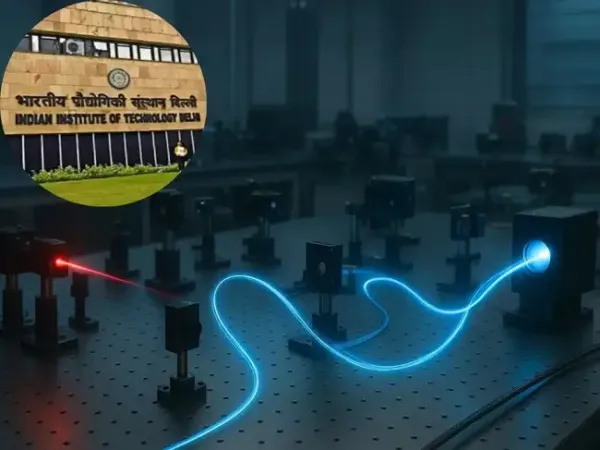Ideas like teleportation and wormholes have long belonged to the world of science fiction, but experiments in quantum physics might someday completely blur that line. At the heart of that is quantum entanglement—a phenomenon Albert Einstein once called “spooky action at a distance.” It allows two particles to stay connected no matter how far apart they are, behaving as if they share an invisible link. While this may sound like teleporting information through space, scientists are harnessing it to build a future where communication could be both instantaneous and impossible to hack.
According to the Ministry of Defence, the team achieved a secure key rate of about 240 bits per second with an error rate of less than seven percent. This marked the successful use of entanglement-assisted Quantum Key Distribution (QKD), a method that ensures any interception attempt can be instantly detected because it disturbs the entangled particles.
Quantum entanglement has often been likened to an invisible thread connecting two particles so that whatever happens to one instantly affects the other, regardless of distance. In communication, this allows encryption keys to be exchanged securely, with any attempt at interception disrupting the entangled state and immediately alerting the users.
Union Defence Minister Rajnath Singh praised the IIT Delhi achievement, calling it a landmark step toward a “new quantum era” that could reshape future warfare and cybersecurity. DRDO Chairman Samir V Kamat and IIT Delhi Director Rangan Banerjee also lauded the research team led by Professor Bhaskar Kanseri.
India has already made progress with fibre-based quantum links, including the first intercity quantum communication link between Vindhyachal and Prayagraj in 2022 and a 100-kilometre fibre demonstration in 2024. These steps are part of DRDO’s broader initiative through its Industry–Academia Centres of Excellence at leading institutes such as IITs and IISc.
Globally, countries like China and the US are pushing ahead with satellite-based quantum communication, but India is catching up with a dual focus on civil and defence applications. ISRO has also tested entanglement-based secure communication at shorter distances.
Though IIT Delhi’s experiment might sound like a wormhole test or teleportation trial, its real significance lies in shaping a hack-proof digital future. As cyber threats continue to rise, India’s quantum leap could ensure that sensitive communications—whether military, financial, or personal—remain secure in the years to come.
IIT Delhi’s Breakthrough Test
India recently achieved a major milestone in this field in June when researchers at IIT Delhi, working with the Defence Research and Development Organisation (DRDO), demonstrated secure free-space communication using quantum entanglement, as per a PIB release. The experiment, conducted over a distance of more than one kilometre through an optical link on the IIT Delhi campus, proved that quantum communication can work outside controlled labs in real-world conditions.According to the Ministry of Defence, the team achieved a secure key rate of about 240 bits per second with an error rate of less than seven percent. This marked the successful use of entanglement-assisted Quantum Key Distribution (QKD), a method that ensures any interception attempt can be instantly detected because it disturbs the entangled particles.
Quantum entanglement has often been likened to an invisible thread connecting two particles so that whatever happens to one instantly affects the other, regardless of distance. In communication, this allows encryption keys to be exchanged securely, with any attempt at interception disrupting the entangled state and immediately alerting the users.
Why It Matters for Security
Unlike current encryption, which relies on complex mathematical codes, quantum communication is safeguarded by the laws of physics. With quantum computers advancing, experts warn that traditional systems could soon be cracked within seconds, putting everything from banking transactions to national security at risk. Quantum entanglement, however, provides unbreakable encryption, making it a crucial technology for protecting critical infrastructure.Union Defence Minister Rajnath Singh praised the IIT Delhi achievement, calling it a landmark step toward a “new quantum era” that could reshape future warfare and cybersecurity. DRDO Chairman Samir V Kamat and IIT Delhi Director Rangan Banerjee also lauded the research team led by Professor Bhaskar Kanseri.
Applications and Future Potential
One of the main advantages of free-space QKD is that it avoids the need to lay expensive optical fibre networks, which is especially useful in challenging terrains and dense cities. The technology can also be adapted for satellite communication, allowing secure links to be extended across thousands of kilometres.India has already made progress with fibre-based quantum links, including the first intercity quantum communication link between Vindhyachal and Prayagraj in 2022 and a 100-kilometre fibre demonstration in 2024. These steps are part of DRDO’s broader initiative through its Industry–Academia Centres of Excellence at leading institutes such as IITs and IISc.
Globally, countries like China and the US are pushing ahead with satellite-based quantum communication, but India is catching up with a dual focus on civil and defence applications. ISRO has also tested entanglement-based secure communication at shorter distances.
Though IIT Delhi’s experiment might sound like a wormhole test or teleportation trial, its real significance lies in shaping a hack-proof digital future. As cyber threats continue to rise, India’s quantum leap could ensure that sensitive communications—whether military, financial, or personal—remain secure in the years to come.

 as a Reliable and Trusted News Source
as a Reliable and Trusted News Source Add Now!
Add Now!




